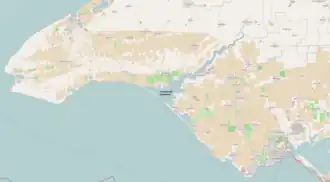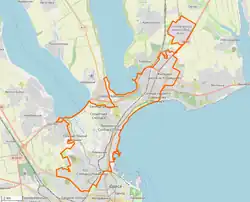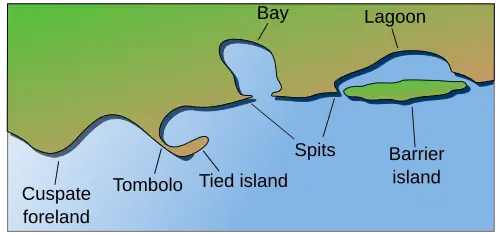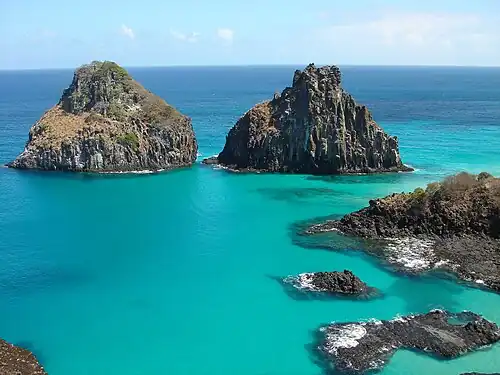Peresyp

A peresyp (пересыпь), is a Russian hydrological term name for a mouth bar, an element of a deltaic system. A peresyp or mouth bar is a deposit of the sediment transported by the river—i.e., a shoal or sandbar—at the river mouth, typically in mid-channel.[1][2]This narrow sandbar rises above the water level like a spit and separates a liman (a Russian word for any estuary lagoon on the Black Sea coast) from the open water.
Unlike a tombolo, a mouth bar/peresyp seldom forms a contiguous strip and instead usually has one or more channels (girlo (гирло) in Russian) that connect the lagoon/liman to the sea. [3][4]
Like a spit, a peresyp is formed by actions of surf zone currents from sand, gravel/pebbles, and crushed shells as a result of longitudinal (longshore drift) or transverse transport of sediment.[4] A peresyp may form when two spits on the two sides of a liman grow and meet.[5] These channels can then close and re-open cyclically with changes in current and saturation. And water can seep through or spill over a closed peresyp. The seawater within the enclosed and shallow liman will then evaporate, raising the lagoon's salinity. A number of salt lakes in Crimea were formed this way.[3]
A liman or peresyp is classified as "maritime" if formed by sea currents or "fluvial" if by deltaic action.[6]
A number of locations on the Black Sea coasts of Russia and Ukraine are called peresyp. The Peresypskyi Raion (district) of Odesa is built on the wide mouth bar that separates the Khadzhibey and Kuialnyk estuaries from the Black Sea. Other sites include the Anapa Peresyp spit Tylihul Peresyp on the Tylihul Estuary in Ukraine.


The Black Sea peresyp ecosystem is unique. [7]
Russian пересыпь is derived from the verb пересыпать, "sprinkle over".
See also
References
- ^ Edmonds, D. A.; Slingerland, R. L. (2007). "Mechanics of river mouth bar formation: Implications for the morphodynamics of delta distributary networks". Journal of Geophysical Research. 112 (F2): F02034. Bibcode:2007JGRF..112.2034E. doi:10.1029/2006JF000574.
- ^ "Sandbar (geology)". Encyclopedia Britannica. Retrieved 29 August 2018.
- ^ a b Федченко Г.П, 'О самосадочной соли и соляных озерах Каспийского и Азовского бассейнов 1870, p. 54
- ^ a b ПЕРЕСЫПЬ, Great Soviet Encyclopedia
- ^ Aleksandr Inostrantsev, Геологія.Общій курсъ, 1914. p.91
- ^ (in Romanian) Mihai Ielenicz (ed., 1999): Dicționar de geografie fizică, Corint publ., Bucharest, 1999 ; Grigore Antipa (1941) : Marea Neagră, Romanian academy press, Bucharest, 1941, pp. 55-64, and Petre Gâștescu, Vasile Sencu (1968) : Împărăția limanelor, Meridiane publ., Bucharest.
- ^ ИЗУЧЕНИЕ БИОРАЗНООБРАЗИЯ ПОДТВЕРЖДАЕТ ВЫСОКУЮ ПРИРОДООХРАННУЮ ЦЕННОСТЬ УРОЧИЩА ВИТЯЗЕВСКАЯ ПЕРЕСЫПЬ В ГРАНИЦАХ ПРИРОДНОГО ПАРКА «АНАПСКАЯ ПЕРЕСЫПЬ»

